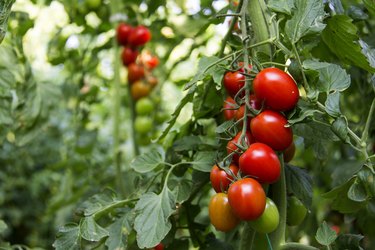
If the once lush foliage on your tomato (Solanum lycopersicum) plants begins to look ragged and stippled with a worrying yellow hue, then they are more than likely suffering from a magnesium deficiency. A quick application of Epsom salt can revive the plant and encourage better fruit.
Symptoms of Magnesium Deficiency
Video of the Day
Magnesium deficiency typically shows up on the leaves. The foliage will show thick green veins over a sickly yellow. This is called interveinal chlorosis. The deficiency may also show up as red, brown or purple as the plant continues to crave magnesium. If left unchecked, the foliage may fall, and it could affect the taste and amount of fruit that the plant produces.
Video of the Day
Magnesium for Healthy Tomatoes
The vital plant nutrient magnesium helps with chlorophyll production. Plants can become deficient in magnesium if fertilizers high in potassium have been heavily applied or overused in the garden. Free-draining and sandy soils can lose magnesium after a heavy rain or as a result of overwatering.
Perform a Soil Test
Before putting down Epsom salt, you may want to test the soil. Epsom salt is neutral and won't affect the pH balance of highly acidic soil, which is often very low in magnesium. A sprinkle of Epsom salt won't cure the problem and the soil will need to be balanced with fertilizers for tomatoes. The best pH level for tomatoes is 6 to 6.8. Take a sample of the soil to a gardening center that performs soil tests or buy a soil test kit.
To test the soil at home, remove a good scoop of dirt from 6 inches below the soil line in the garden bed. Mix a little water with 2 tablespoons of soil until it is moist. Add 1/2 cup of vinegar to the wet soil mixture. Wait a few minutes for it to fizz. If it reacts to the vinegar, then the soil is alkaline.
If there is no reaction, do the same test with a new scoop of fresh soil. Add a little water and 1/2 cup of baking soda. If the soil fizzes when introduced to the baking soda, then the soil is acidic.
Epsom Salt Basics
While Epsom salt has the same texture as the grains in the table shaker, it is not salt. Epsom salt is actually magnesium sulfate. The name hails from the town where it was discovered, Epsom in Surrey, England, in the early 1600s. It has been used by nutritionists and gardeners for human and plant health for centuries.
To add Epsom salt to potted plants, dissolve roughly 2 tablespoons into a gallon of water. Apply this mix to the base of the plant in lieu of regular watering one day a month. Or put a teaspoon of Epsom salt into a 1-quart spray bottle and fill with water. Spray this directly onto the affected leaves on nonrainy days or on days with high temperatures.
Tomatoes growing in an outdoor garden bed can use 1 tablespoon of Epsom salt per foot. If the plant is 2 feet high, add 2 tablespoons of Epsom salt to the soil around the base of the plant twice a month. Tomato seedlings can get a good dose of Epsom salt to help strengthen cell walls and build strong roots for healthy blooms. Sprinkle Epsom salt over the garden bed and work it into the top inch of the soil. A cup of Epsom salt can cover about 100 square feet.